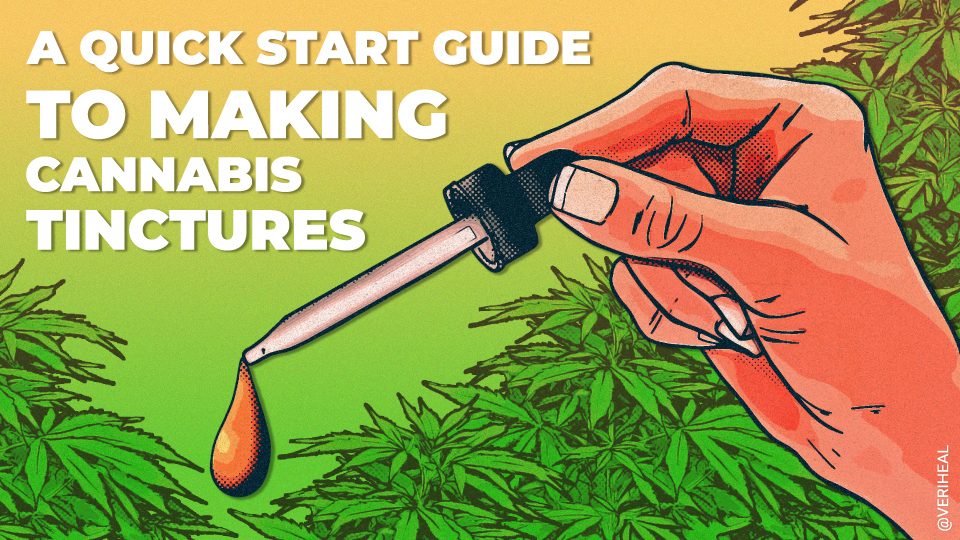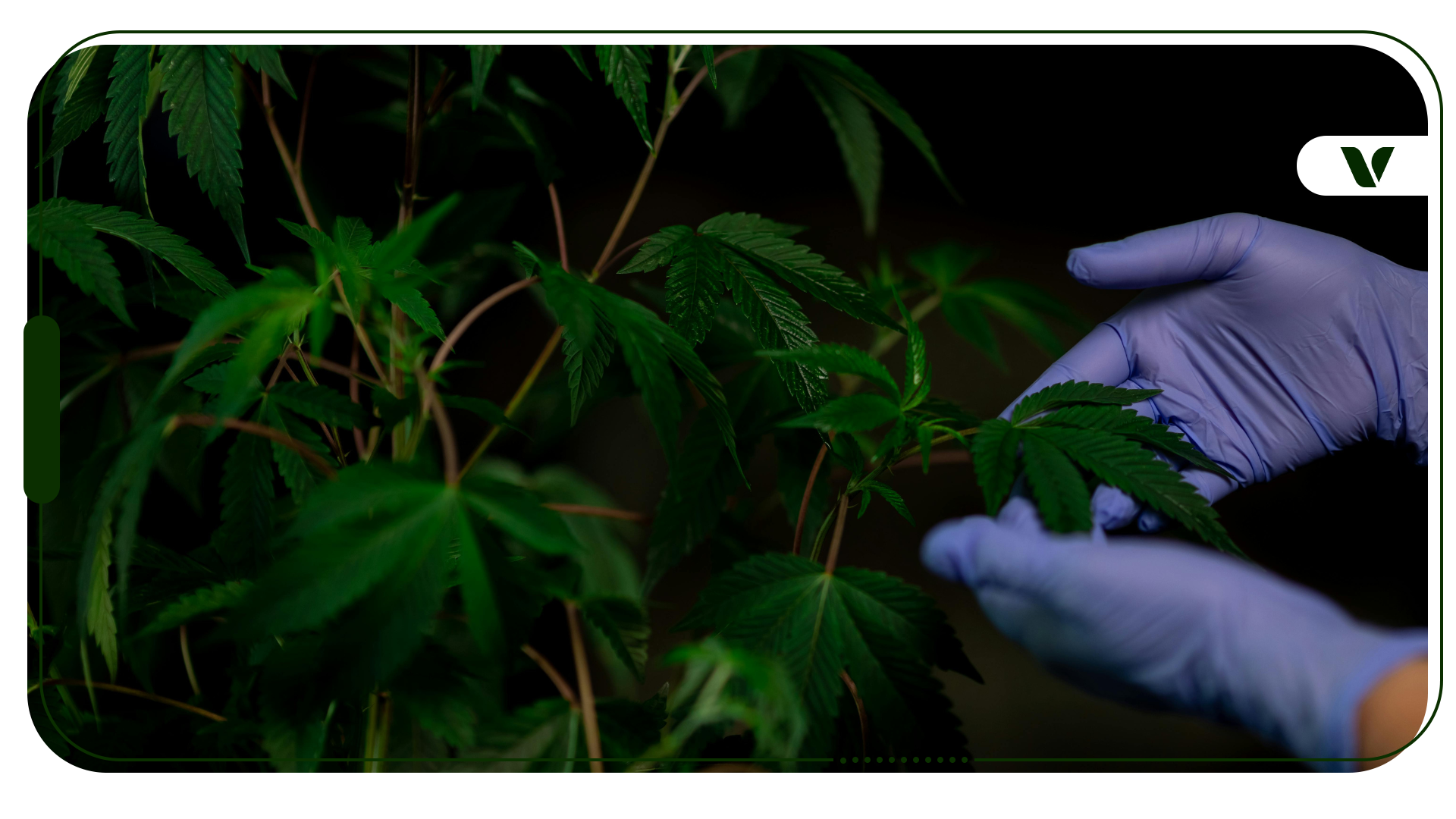Cannabis tinctures are relatively new on the scene compared to the long, thousands-year-old history of the cannabis plant itself. It was first recognized for its medicinal use in European medicine in 1839, and by 1851, medicinal cannabis tinctures had made their way into a drug almanac known as the United States Pharmacopeia. Despite prohibition throughout the decades, tinctures have prevailed as an excellent (and smoke-free) consumption method for medicinal and recreational cannabis users alike.
Traditionally, tinctures are “medicine suspended in alcohol.” And that’s precisely what cannabis tinctures remain today (although the definition has expanded a bit to include oil- and glycerin-based tinctures). Making tinctures is incredibly simple—you just need a little time for the high-proof grain alcohol and decarboxylated cannabis flower to mingle into a potent concoction. Delicately serving yourself a dropperful at a time will make you feel one part doctor and one part witch (No? Just me?).
Let’s explore these versatile cannabis products and how to make them at home.
- Understanding Tinctures
- What Type of Alcohol Is in a Tincture?
- How Long Does It Take to Feel a Tincture’s Effects?
- What Is Considered a Full Tincture Dose?
- Two Major Benefits of Tinctures
- Simple Measurements
- Multiple Delivery Methods
- Step-by-Step Cannabis Tincture Recipe
- Tools
- Ingredients
- Steps
- Proper Tincture Storage
- Final Takeaway
Understanding Tinctures
Before you jump into making tinctures, it’s crucial to learn the basics. While tinctures are known to pack a punch, they are still gentle and easy enough for beginners.
What Type of Alcohol Is in a Tincture?
When choosing alcohol for your tincture, you should look for clear grain alcohol with high alcohol content. The most commonly used is 190-proof Everclear (the label is usually navy blue and gold). Unfortunately, the sale of 190-proof alcohol is not allowed in some locations. If that’s the case for your area, you may be able to order online and have it delivered. Otherwise, you should look for high-proof clear alcohol at your local liquor store. Ideally, it will be higher than 120 proof (but look for 151 proof first).
Wondering if you can skip the alcohol entirely and use another carrier like MCT oil or glycerin? Technically, yes, you could. However, neither MCT oil nor glycerin are as quick and effective at delivering medicinal benefits when administered sublingually (under the tongue). Both stall sublingual absorption because they take longer to be broken down by saliva than alcohol does, but that shouldn’t stop you from trying MCT or glycerin tinctures for other purposes.
How Long Does It Take to Feel a Tincture’s Effects?
Alcohol-based cannabis tinctures taken sublingually provide much quicker relief than traditional edibles. The effects can feel more potent and come on more quickly because your mouth—particularly under the tongue—is full of capillaries close to the surface of very porous skin. And that means quick absorption directly into the bloodstream.
So while traditional edibles can take up to 2 hours to fully kick in, tinctures often take effect in under 30 minutes. Remember, though, that every person metabolizes THC differently, so your experience may differ.
What Is Considered a Full Tincture Dose?
A full dose is really whatever your body needs, which will be different for everyone. Tinctures are dosed as milligrams of THC and/or CBD per milliliter (mg/mL), as a typical dropper holds about a milliliter of liquid. A typical tincture dose is 10 mg/mL (or 10 milligrams per dropperful), but many products range from 1-20 mg/mL. For this reason, it’s crucial to be aware of the strength of your specific tincture (whether homemade or from a dispensary).
Keep in mind that tinctures hit a little bit harder than edibles since they skip the body’s digestive and filtration systems. A 10-milligram dose of THC may be too much for newer cannabis users, so it’s always best to start with half of the recommended dose (perhaps 5 milligrams) and work your way up. Grain alcohol is incredibly harsh, both on the tongue and in the stomach, so it’s best only to take what you need.
Two Major Benefits of Tinctures
Tinctures are an excellent choice for new edible users and makers for two significant reasons. First, they are easy to measure and dose. Second, you can use them in various ways, none of which involve exposing your lungs to smoke.
Simple Measurements
Precise measurements are essential no matter your intent when consuming cannabis orally, as the effects tend to linger much longer than with inhaled cannabis. Those new to cannabis need to be cautious to avoid ingesting too much THC, which can lead to adverse effects like paranoia. Many medicinal cannabis users need to use an exact dose of THC and/or CBD to manage their symptoms.
Dosing tinctures with a dropper means getting precise and small doses every single time—no uncertainty about your intake, and no anxiety about potentially taking too much. Because tinctures are so easy to measure, they’re the go-to consumption method for cannabis microdosers. With their ability to pack precise yet powerful punches, tinctures are great for both new and seasoned cannabis users.
Multiple Delivery Methods
In addition to being easy to dose, tinctures are easy to consume—and can be in a variety of ways. The most popular way to consume tinctures is sublingually, which involves holding the liquid under your tongue for 30-60 seconds before swallowing it. As mentioned above, this allows the cannabinoids to be absorbed directly into the bloodstream, producing quicker effects. When taking tinctures sublingually, alcohol tinctures reign supreme.
If sublingual consumption isn’t for you, tinctures can also be easily blended into drinks and food—just keep in mind that the effects will take a bit longer to kick in. Tinctures can also be used to make homemade edibles, such as hard candies, brownies, or cookies, by adding the liquid directly or using it to make cannasugar. Finally, tinctures made with vegetable glycerin are safe to use in a tank-style vape pen (but do not try this with alcohol- or MCT oil-based tinctures, as they are dangerous to vaporize).
Step-by-Step Cannabis Tincture Recipe
Are you ready to make your own DIY cannabis tincture? Here’s what you need and how to do it.
- Scale
- Sheet pan
- Tinfoil*
- Mason jar
- Measuring cup
- Mesh strainer
- Cheesecloth or coffee filter
- Amber/dark-colored glass dropper bottle or jar for storage**
- Dropper*
*Optional
**An airtight glass jar or bottle is more important than the color.
Ingredients
- 3.5-7 grams of raw cannabis flower
- 2-4 ounces of high-proof, clear grain alcohol (190 proof is best)
Note: My preferred ratio is 4 grams of flower to 3 ounces of alcohol, and I typically end up with about 11-15 mg/mL doses of THC and about 2.5 ounces/75 milliliters of tincture.
Steps
- Decarboxylate the cannabis flower. Preheat the oven to 240 degrees Fahrenheit. Roughly chop the cannabis buds so that the pieces are all about the same size (about half the size of a popped popcorn kernel). Spread the plant material in an even layer on the baking sheet. Cover with tinfoil to preserve terpenes and trap the scent. Bake for 30-40 minutes until the flower smells brighter and the buds have turned slightly darker (almost browned).
- To preserve terpenes, allow the pan to cool for 15 minutes or more before moving on to the next step.
- Combine the decarbed flower and alcohol in a mason jar and screw on the lid. Shake it gently, and then place the jar in a cool, dark place for at least two weeks. Give the jar a gentle shake every day over those two-plus weeks.
- Once the soak is complete, line a mesh strainer with cheesecloth, strain the flower from the alcohol, and store it in a dark-colored jar in a cool, dark place.
Proper Tincture Storage
Storing tinctures is straightforward. First, you need a clean glass receptacle to hold it in. Amber or opaque glass is best. The next step is to keep that jar away from excess heat and light. A cabinet located directly next to your oven/stove is a good spot. I’ve also taken to keeping alcohol-based tinctures in the freezer.
Alcohol-based tinctures have an indefinite shelf life if stored in an airtight container in a cool, dark place. However, the potency may degrade over time, so it’s probably best to use it in six months or less. Vegetable glycerin has a shelf life of two to four years, but THC potency probably won’t last that long. And MCT should be treated like coconut oil. In short, use it or lose it, and try not to make more than you can use in a few months.
Final Takeaway
If the easy dosing, low maintenance infusing, and plethora of applications haven’t sold you on tinctures, let me give you one last point for the “pros” column: Tinctures are discreet and easy to hide from stigmatizing eyes (or noses). After decarboxylation, tinctures have virtually no smell, and certainly not enough to permeate walls. As a result, they’re easy to take or add to other food or drinks without letting everyone know what you’re doing.
Mastering tinctures is a breeze, and they’re sure to become a staple in your cannabis-friendly kitchen and medicine cabinet. The ease of use and many applications will have you reaching for that bottle frequently. If you want to learn more about using tinctures for medicinal purposes, talk to a licensed medical cannabis doctor in your state.
This blog post was originally written by Kat Helgeson and published on 12/4/19. Updated 5/2/22.
Author, Share & Comments









